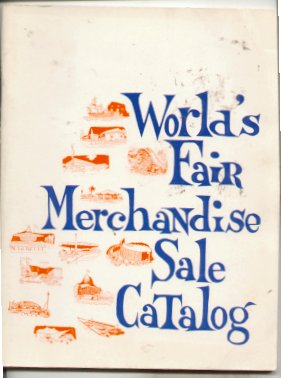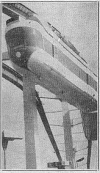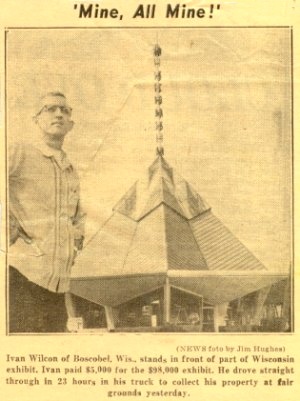|
Source: The
Wall Street Journal, Tuesday, August 31, 1965
BARGAINS
The Great Souvenir Sale
|
| Time Magazine, October 8, 1965 |
|
|
WHERE CAN A bargain hunter buy
three live elk for $500 each, a small-scale Mississippi paddle-wheeler
for $7,500, or a connoisseur's collection of African voodoo drums
and five-foot spears? Answer: at the New York World's Fair, where
the greatest sale of surplus goods since the big postwar auctions
of military gear is about to take place. As the Oct. 17 closing
date approaches, the selloff by the Fair's 300 exhibitors is
beginning in earnest.
American Machine &
Foundry has several bidders for its seven-train monorail, which
cost $5,500,000 to erect but will go for about $1,000,000. For
$5,000 each, Greyhound has already sold all 62 of its 54-passenger
glider trains to 29 buyers, including Mack Trucks, the University
of Connecticut, several amusement parks and the city of Stamford,
Conn. Borden Co. will pay about $35,000 to the Wisconsin pavilion
for the world's largest cheese, a 34,591-lb., 14 1/2-ft.-long
cheddar, which the company plans to haul in a refrigerated "cheesemobile"
and display around the U.S. To their employees, Ford will sell
most of its cars, Du Pont its furniture and RCA its color TV
sets -- at substantial markdowns.
|
|
Sari to Go. Most of the exhibitors would
like to sell just about everything, intend to offer their goods
either at auction or for a fixed or negotiated price. There are
so many possibilities for the general public that a New York
City adman, George E. Procell, 25, has put together an 80-page
catalogue of merchandise, already has orders for 8,000 copies
at $2 each. for art collectors, The Spanish pavilion has listed
a 47-inch, 16th century painted wood sculpture of the Virgin
for $11,590, and the Philippine pavilion is offering to the highest
bidder twelve hand-carved panels that depict Philippine history
and took 30 workmen more than a year to make. The Philippines
also want to dispose of a 70-ft.-high Oriental-style restaurant,
and Guinea wants to get rid of its voodoo tom-toms, native spears
and a 40-ton air conditioner (all for the best offer).
Pakistan is offering
saris for $15 to $45 and 17 tall cedars (for the best offer).
Israel is marketing fur coats, and Ireland is selling lace and
sweaters (highest bids). Thailand wants to sell its temple-like
pavilion. Montana wants to sell a 300-ft.-long boardwalk, a 56-ft.-long
public lavatory, and its live elk. Florida is asking $50,000
for Smokey, a porpoise trained to spit out fires and play basketball.
Dozens of companies are selling computers, typewriters, video
tape recorders and other equipment.
Some of the goodies
will be given away. Equitable Life will donate its furniture
to a school for crippled children, and Coca-Cola will send its
electronically croaking bullfrog to Caroline Kennedy, who said
she wanted it. Many of the buildings have been offered free to
anyone willing to take them apart and put them together again.
The Cockaigne Ski Center near Jamestown, N.Y., paid a token $3,000
for Austria's handsome Alpine-style pavilion, but will have to
spend about $190,000 to transport and reassemble it. the Christian
Science pavilion will be shipped 4,650 miles via the Panama Canal
to Poway, Calif., where it will become a church. Cost: $79,000.
|
| Journey to Disneyland.
Many of the
most popular displays will be used elsewhere by their owners.
Though wreckers will get the Johnson's Wax pavilion, the company
intends to continue showing its splendid film, To Be Alive,
perhaps at its Racine headquarters. Walt Disney will take
back his electronic, talking Abe Lincoln from the Illinois pavilion,
his moving cavemen from Ford, and his thousands of gay puppets
from Pepsi-Cola's lively "Small World"; all will probably
appear in Disneyland. Though the Fair's wax museum has optioned
its four mop-topped Beatles to a Cleveland customer for $6,000,
it will simply shift some other figures to Broadway. There Charles
de Gaulle will show up in the permanent display at Ripley's Believe
it or Not. |
New York City adman, George E. Procell's
80-page catalog of merchandise available from the Fair, courtesy
of Craig Bavaro.

From the catalog...
|
The publisher and editor wish the reader success in finding and
purchasing his heart's desire, whether it be a carousel, an elk
or an elephant-foot stool. |
|
S-12 / 65 EXTRA LARGE SILENT 16mm FILM
PROJECTORS, made up of the following components:
- Xenosol II lamp housing type 23-23
- Norelco projection heads - 16mm - silent
type 101659
- Knitron 230V-10 amp. rectifiers
Continuous loop film feeder suitable
for use in creating various theatrical backdrops.
|
Bell Telephone Pavilion
9AM-5PM
- After Fair
- 9AM - 5PM
|
$4000 /Best offer each |
| S-15 / CASTLE- 50' x 30' x 20' strn steel
construction fiberglass stone exterior. Two turrets-steel frame.
Can be dismantled and re-erected in sections. |
Santa Maria Pavilion
9AM-11PM
- After Fair
- 9AM-5PM
|
$75000 / $25000 |
| No. B-7 / One PUBLIC RESTROOM BUILDING,
16' X 56', 6 rooms and full length hall complete with showers.
Log sided, flat roof, prefab, easily dismantled, natural finish
exterior, 4' panels. |
Montana Pavilion
9AM-5PM
- After Fair
- by Appointment
|
- / $2000 |
|
MAJOR INDUSTRIAL EXHIBIT:
This unusual pavilion contains a redwood
garage, large redwood flower boxes, gazebos, aviaries, two small
glass buildings 10' x 6' x 10', clocks, clear plexiglass, and
a most unusual bleacher arrangement that can lift 500 people
into the upstairs theatre. The wall is worked by compressed air.
|
|
PRICES ... ARE OPEN TO BIDS. |
| S-2 / 3 ELK, one two-year-old heifer, one
three-year-old cow, one four-year-old bull, captured at Bison
Range in Montana by the Montana Fish and Game Commission. These
elk are all in excellent health and good physical condition.
If you're proud of your front lawn, why settle for a ceramic
deer? |
Montana Pavilion
9AM-5PM
- After Fair
- by Appointment
|
- /$500 each |
|
The World's Biggest Rummage
Sale
|
Porcell isn't the only
salesman on the lot. The demolition companies that moved in the
moment the gates closed at midnight Sunday are in the selling
business, too. The demolition men bid on wrecking jobs on the
basis of how much they can salvage for sale. If they're very
lucky they may sell the building intact to be reerected elsewhere.
If not, they will try to sell it brick-by-brick.
"We try to create
a purpose for every item," explained Harry Avirom, Eastern
district managing director for the Kaiser-Nelson Steel &
Salvage Corp. "We just sold the Parker Pen building -- one
of the 25 pavilions we contracted to demolish -- to a plastic
surgeon who wants to put it up as a summer home out on Montauk
Point."
"We have a huge
list of requests from people who want to buy things from us,"
Avirom said. "A woman wrote that she wants one of the gazebos
from the IBM building to use as a cage for beautiful plumed birds.
Jean Dalrymple, the theatre producer, asked if she could have
some of the white birch trees
|
from the New England
exhibit to replant on her country estate. A man bought the rough
log fence around the Avis exhibit to use on his property. The
stone wall of the Irish pavilion is being bought for flagstone
walks."
On Wrecker's
List
Avirom said Kaiser-Nelson
is low-bidder on both the Spanish pavilion and the Federal building
if it is decided that these beautiful buildings are to be demolished.
Private negotiations are going on to retain the $11.5 million
Federal building as a school for dropouts, but neither building
is on the preliminary list of Fair buildings to be preserved.
A special committee
appointed by Mayor Robert F. Wagner designated only 19 structures
to be retained as part of a proposed Flushing Meadow park. Among
them are the Unisphere, the Singer Bowl, the heliport, the Hall
of Science, the marina the U.S. Rubber ferris wheel and three
holdover buildings from the 1939-40 World's Fair.
|
The Monorail, one of
the big attractions of the 1964-65 Fair, is still on the market.
The Lipsett wrecking company is asking $1 million for the aerial
railroad which American Machine & Foundry Company spent $5.5
million to build.
"We've been negotiating
with several prospective buyers," a spokesman for Lipsett
said. "One city is thinking of using the Monorail to transport
visitors from downtown hotels to a new convention hall. another
town is considering using it to shuttle people from a parking
area to a sports arena. We've had other inquires from Japan,
from colleges and from large industrial firms.
Lipset also is dismantling
the General Motors pavilion, the most popular attraction at the
Fair. The famous Futurama Ride, which drew thousands of visitors,
is being destroyed. "It cost GM about $5 million to design
and build that ride," the Lipsett spokesman said,
|

The Monorail,
built by American Machine & Foundry for $5.5 million, is
bargain-priced at $1 million.
"and they don't
want some fair out in Nebraska getting hold of it and capitalizing
on their idea."
Before Kaiser-Nelson
wrecks the Hollywood pavilion, the celebrities who left the imprint
of their feet, hands and other identifying symbols in the cement
courtyard will be asked to claim their paving blocks as a souvenir.
If they don't, the concrete autographs will be offered free to
their adoring fans.
A girl from Long Island
has her order in already. She wants Liberace's signature and
candelabra symbol.
Play that
on your piano.
|
Source: Sunday
News, October 24, 1965

Source: New York
Daily News, Friday October 22,
1965
|

